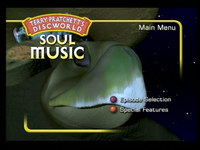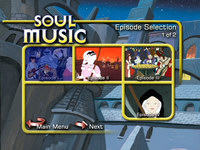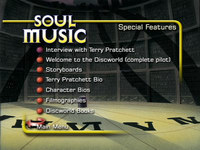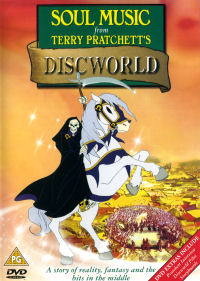
10.9.2010 #489
English Version 6.5.2013
by Guido Bibra
• Discworld Pilot
• Storyboards
• Terry Pratchett Biography
• Character Biographies
• Filmographies
• Discworld Bibliography
![]() Die Serie
Die Serie
Even Death needs a holiday sometimes, but on the Discworld this can have strange effects. Luckily the Grim Reaper has an adequate holiday replacement with his adopted granddaugter Susan, even if the young lady has a few beginner's problems with her new job. Meanwhile, Imp Y Celyn, a young bard from Llamendos, arrives in Ankh-Morpork to take his chance as a musician. He meets the troll drummer Lias and the dwarf saxophonist Glod, who join forces against the opressive musician's guild. But strange things happen when they go to a mysterious music store and Buddy neé Imp buys a Guitar with a life of its own...
For a long time, Terry Pratchett's Discworld novels were regarded as completely unfilmable and the author did not take a chance with television or cinema adaptations. The SkyOne adaptations of Hogfather, The Colour of Magic and Going Postal have since changed this, but the way for these successful movies was paved in the late 1990s by two projects of the british animation studio Cosgrove Hall. For these, Wyrd Sisters and Soul Music, two of Terry Pratchett's most popular novels were chosen, of which the latter one proved to be the more ambitious adaptation. Not only a top-notch animation with good voice acting had to be produced, but also an appropriate soundtrack.
While Terry Pratchett's first Discworld novels were more or less straight fantasy parodies, in the later stories the flat world had evolved out of the dark ages. Moving Pictures had introduced the film industry into the Discworld and a couple of books later Terry Pratchett continued the theme with the emergence of pop and rock in Soul Music. He also took this opportunity to continue the story of Death's adoptive daughter Ysabell from Mort and made her daughter Susan the actual protagonist of the book. The story about the most unique band in all of fantasy was riddled with countless references to music history and for this reason was not exactly an ideal candidate for an animated adaption, but this did not stop Cosgrove Hall at all.
Soul Music is one of the longer and more complex Discworld Stories, which could not be divided into only four episodes like Wyrd Sisters. Script writer Martin Jameson and author Terry Pratchett hat therefore decided to leave the main part of the story intact and split it into seven 24-minute episodes with a runtime of nearly three hours. Of course the story had to be tightened and smaller subplots had to be eliminated or shortened, but altogether the original story had not been changed much. The similarities to the career of the Beatles were put more into the foreground, but Terry Pratchett's sharp dialogue, which was already fit for a script, was adopted nearly unchanged. Director Jean Flynn, who was also responsible on Wyrd Sisters, had a perfect script to work with.
The visual design of Soul Music was a huge challenge for Cosgrove Hall, because the locations were not limited to a handful of sceneries, but wandered all over the Discworld and even did not stop at supernatural residences. On one side, the chaotic, colourful and a bit grimy Ankh-Morpork had to be shown, but on the other side Death's completely monochrome estate and many other cities around the Discworld during the many tour stops of the band. The backgrounds were impressivly detailed and a real feast for the eyes, but were mostly seen only for a short time.
The character design was of course simpler, but still much more complex than in many other animated series. Following the typical style of Cosgrove Hall, the animators worked less with shades and gradients than with clear lines and single-coloured surfaces, which, however, gives the characters only a slightly cartoon look. The faces are not caricartures in the first place, but are more geared towards realism with their very expressive and dynamic facial expressions.
For Death, a very original solution was found: in order not to show the viewers only a rigid skull, it was brought to life with a set of completely unrealistic, but in the realms of animation entirely natural-looking movements. This did not fall for the old cliché of a moving jaw, but instead used the whole skull for brilliant "facial" expressions. Although, like many other animated productions, Soul Music had been made with half the usual framerate, movements looked always fluid and even in the more complex crowd scenes were completely realistic.
Like with Wyrd Sisters, Cosgrove Hall had a good hand with the casting of the voices for Soul Music. Especially remarable was the problem of finding a perfect voice of Death, who is an antropomorphic personification and basically a real person, but still adheres to the skeleton-and-scythe mythos. In his books, Terry Pratchett had described his voice as closing coffin lids and may even have thought of horror film legend Christopher Lee. Surprisingly, Cosgrove Hall was not only able to find someone sounding like the actor, but to really hire him, giving the personified Death, who is actually not frightening but very human, exactly the right voice. Not many other actors could have filled this role better than Christopher Lee, who does not even need any artificial reverb or echo with his sonorous voice to fully embrace his character.
There is no real cental main character in Soul Music, because the plot is an ensemble story, making the casting of the many characters especially difficult - but Jean Flynn and her Team at Cosgrove Hall had really risen to the occasion. For Death's granddaughter Susan the producers had chosen an old acquaintance: Debra Gillet had already voiced one of the lead roles in their stop-motion adaptation of Truckers. The actress brings the many different sides of Susan Sto Helit - from a somewhat shy, but fatalistic teenager to Death's granddaughter in the line of duty - brilliantly to life and makes her character completely her own.
A lucky find was Andy Hockley, who was more known on the stage than in film and television. He was able to bring exactly the right youthful energy and audaciousness into the young bard-come-rockstar Imp Y Celyn. He also gave his voice a perfect, but not too intrusive accent resembling a delicious Mersey twang. Robert Rackstraw, a very busy british voice actor, as the dwarf saxophonist Glod, also sounds like he could have gone to school together with John Lennon or Paul McCartney, but the choice for the drummer Lias alias Cliff was even better: George Harris gave the troll, a species really based on rock on the Discworld, a wonderful gravelly jazz man voice, which could not have been selected better.
While animation and voice actors are one half of Soul Music, the music is responsible for the other half of the series' success. This time, not only the usual background score was needed, but the musical evolution of the Band With Rocks In described in the novel had also to be implemented. Cosgrove Hall was lucky to have Keith Hopwood and Phil Bush on board, a team of musicians who were able to create a series of songs to chronicle a journey through music history from the end of the 1950s to modern pop music.
Altogether eight songs and one instrumental were recorded, so that each episode of the series could be devoted to a musical epoch. The journey starts with a deliberately shakily performed folk song called Gathering Rhubarb, which had already been mentioned in a couple of earlier Discworld stories, but this was quickly followed by Big Moon Rising, an early rock'n'roll cracker in the style of Chuck Berry or Elvis Presley. The next entry was Cover Girl, a rousing piano rocker resembling Little Richard and Carl Perkins, while She Won't Change Her Mind was clearly a wonderful Beatles hommage from their catalogue of about 1965. Touchstone was about everything flower power, while Good Lovin' imitated the Blues Brothers very well - in the animation even with the signature suits and shades. Guitar heroes like Jimmy Hendrix, Led Zeppelin or Eddie van Halen were the subject of Pathway to Paradise and the brilliant finale is comprised of a wonderful and moving harp solo, followed by the 1980s pop hymn The Messenger.
All the songs have one thing in common: terrific arrangements which manage to capture the completely different styles spot-on without borrowing too much from the originals. Keith Hopwood, the former guitarist of Peter Noone's Herman's Hermits did not only contribute the singing voice of all songs, but also the brilliant guitar parts, which consisted of very competent rhythm parts and many amazing solos. They go hand in hand with the very successfull arrangements of producer and co-composer Phil Bush, from which many other musicians could learn a lot. The lyrics of the musically brilliant songs are, however, mostly deliberate nonsense digging at the triviality of many old pop songs from the 1950s and 1960s.
With Soul Music, Cosgrove Hall had created an astonishingly successful animated adaption of Terry Pratchetts virtually unfilmable book, which was not only able to delight with great animation and remarkable voices, but also with an awesome soundtrack, which was able to implement the musical elements of the novel perfectly. With this, Soul Music was able to become so much more than a run-of-the-mill animated series, appealing not only to fans of Terry Pratchett but also to music lovers.
![]() Die DVD
Die DVD
Soul Music was released together with Wyrd Sisters in 2000 on DVD in the UK after it had already been available on VHS since about 1998. The original structure of seven episodes was kept and the disc had been outfitted with some very interesting extras like an extensive interview with Terry Pratchett. The image quality is luckily much better than Wyrd Sisters, so there is not much to improve in this highly recommended DVD.
The disc reviewed in this article is from a british double-pack together with Wyrd Sisters, which contained the previously seperatly available DVDs together in a cardboard slipcase. Unfortunately the british DVD is still out of print at this time and is only available second-hand. Since 2009 there is also a German release of Soul Music from the distributor KSM, which has the English soundtrack, but none of the extras of the british edition.

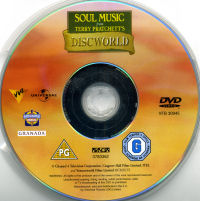
![]() Bild
Bild
While the DVD of Wyrd Sisters was plagued by a VHS-like quality, there is nothing to worry about Soul Music, because here a clean video master was available, reproducing the digitally animated series perfectly.
In comparison to Wyrd Sisters, the image of this DVD is clean as a whistle and completely free of noise and other disturbances. Sharpness is not on the highest level, but this seems to be more a limitation of the animated source than of the video master, which looks quite similar to the early seasons of Futurama. On the other hand there has been no additional sharpening applied, making lines and edges look very clean, while the background look virtually like paintings. Colours are reproduced without any noise and look suitably strong.
The image on this DVD has been progressively encoded and does not have any of the interlacing problems of Wyrd Sisters. The only downside is the sometimes noticable compression - with seven 24-minute episodes and some extras there are almost three and a half hours of video material on only one disc, sometimes causing visible artifacts. But these are hardly as problematic as the terrible video noise on Wyrd Sisters.
In spite of the slight compression problems the image quality of this DVD is very satisfactory and it is even perfectly viewable on larger screens.
![]() Ton
Ton
Like Wyrd Sisters, the soundtrack of Soul Music was mixed as matrix-coded 2.0 Dolby Surround, but was probably labeled as Stereo only for licensing reasons. When played back through a ProLogic decoder, this soundtrack has a lot to offer.
The lone English soundtrack was encoded with the usual 192 kbit/s in Dolby Digital and while the surround flag is not set, it does have a very expressive surround mix. This is mainly provided by the music, which especially in the concert sequences has a very bright and crisp sound to offer. The surround channel is also used by many direct and diffuse sound effects, while the frontal soundstage is surprisingly active as well and is used in its full width. Even the crystal clear dialogue sometimes leaves the center channel and becomes directional.
There are unfortunately no subtitles at all on this DVD, which is somewhat disappointing considering that the dialogue is linguistically not exactly easy to understand.
![]() Bonusmaterial
Bonusmaterial
The bonus materials of the Soul Music DVD can definitiely hold its own, because apart from a long interview with the author there are some other extras like the complete pilot movie and a couple of storyboards. The menu design does, however not fit the series very well and leaves the impression of having been made with a cheap DVD authoring software.
The Interview with Terry Pratchett (31:15) is not only an extensive talk with the author, but also a quite detailed Making-Of, because Pratchett tells a lot about the origin and creation of the series itself.
Welcome to the Discworld (7:34) is the full, but never completed pilot movie, which had been made as a test before Wyrd Sisters and Soul Music.
The Storyboards are from the third episode, but are not especially numerous with only 18 images. These are embedded in a frame which makes them somewhat hard to view.
The Terry Pratchett Bio summarises the career of the author on four short screens.
The seven Character Bios contain a few sparse, but humorously written pages with background information about the characters of the story.
Filmographies is a list of the movies in which Christopher Lee, Graham Growden, Andy Hockley and Debra Gillett have acted in.
Discworld Books has a short overview of the Discworld books released up to the year 2000.
